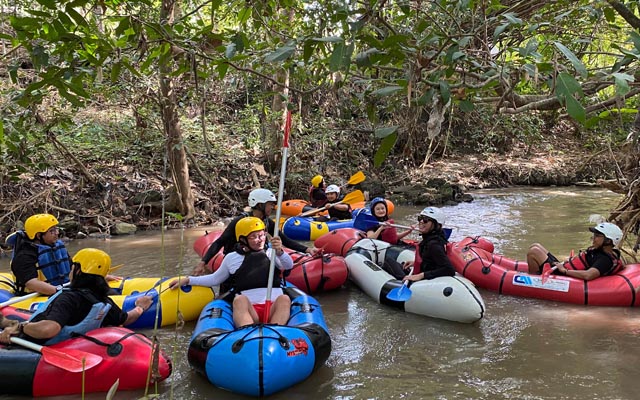Kulon Progo Regency in Yogyakarta, Indonesia is stepping up efforts to attract more tourists by upgrading its tourism village to a premium level.
The upgrades will include the development of homestays, more live-in activities and experiences living with the local community.
 Klong Progo Regency hopes to attract more visitors with travel packages that include activities such as packrafting, as seen in the picture.
Klong Progo Regency hopes to attract more visitors with travel packages that include activities such as packrafting, as seen in the picture.
Yogyakarta Tourism Director Joko Mursit, during a recent media fam trip following the rebranding of Hotel Morazen Yogyakarta, said the presence of Yogyakarta International Airport (YIA) has increased Kulon Progo’s profile, and new developments such as Yogyakarta’s first international standard hospital with a heliport, as well as well-known hotels such as Ibis, Swiss-Belhotel, Novotel and Morazen have led to an improvement in the standard of homestay services and products.
“Community empowerment is the foundation of Kulon Progo’s tourism development. Winning the Indonesian Tourism Village Award for the fourth consecutive year, a record for Indonesia, is proof of the successful development,” said Joko.
The tourism bureau and village authorities are also working with surrounding hotels to provide training, guidance and preparation on how to provide hotel-level service to tourists.
Hengky Tambayong, vice-chairman of the Indonesian Hotel and Restaurant Association (IHRA) Kulonprogo branch and general manager of Hotel Morazen Yogyakarta, said: “We are working with local authorities to accelerate the development of attractions and talent. For example, we have trained food stalls at Gulaga Beach to improve food quality and presentation, and helped villages create service SOPs using hotel standards. We also provide in-house hospitality training for students.”
In fact, Jokowi said competitions are sometimes held between tourist villages, with judges from tourism-related organizations evaluating purchases, stays and overall programs.
The district government has also stipulated that each tourist village must have its own themed package to ensure tourists have many activity options when they visit Kulonprogo and to ensure that the tourism economy is evenly distributed within the district.
“We created travel packages to make it easier for travelers to choose what suits their interests,” Joko explained.
Examples of available packages include bird conservation activities in Jatimulho village, educational tourism in Thinara tourist village, nature tourism in Ngargosari village with views of an ancient volcano, and outbound activities in Hargotirto village.
Apart from cooperating on products and human resource development, Hengke said the parties are also stepping up promotion to raise Kulon Progo’s profile.
YIA has a capacity of 70,000, but the airport handles only about 8,000 to 12,000 passengers a day, with only 20 percent staying in Kulon Progo and the rest heading to Yogyakarta city centre and other cities in Central Java, meaning there is still room for growth, Henky noted.
In addition, IHRA has approached the Yogyakarta Tourism Board to work with airlines to promote cultural and unique events such as the Fisherman’s Festival and Durian Party, as well as urging the Borobudur Authority to include Kulon Progo in its international promotions.

